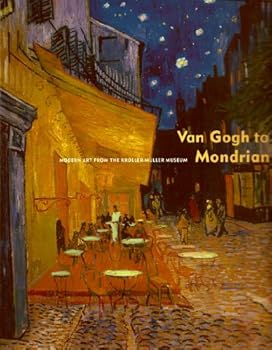Van Gogh to Mondrian: Modern Art from the Kro'ller-Mu'ller Museum
Select Format
Select Condition 
Book Overview
The Kroller-Muller Museum is one of the great art collections in Europe, yet it remains unknown to many Americans because of its remote location in the Hoge Veluwe National Park in rural southeast Netherlands. This beautifully illustrated book features highlights from the Museum's collection of late-nineteenth- and early-twentieth-century art, including more than a score of works by Vincent van Gogh. The Museum is the result of the passion of a singular collector: Helene Kroller-Muller (1869-1939). The wife of a Dutch shipping magnate, she used almost unlimited funds to amass an astounding collection in a short period of time. Beginning in the 1910s, she collected voraciously -- not only Van Gogh but Neo-Impressionist masters Seurat, Signac, and Denis, and Symbolists Redon and Toorop. She patronized and supported artists who were pioneering abstraction -- particularly Mondrian, Van Doesburg, and Van der Leck -- and collected the Cubists, including Picasso, Gris, and Leger. Mrs. Kroller-Muller had a consuming desire to create a museum where her collection could be displayed for the public. Over a period of more than twenty-five years, she worked with some of the leading architects of the early twentieth century -- H. P. Berlage, Mies van der Rohe, and Henry van de Velde -- and finally in 1938 her dream was realized with the opening of the institution that bears her name. Book jacket.
Format:Hardcover
Language:English
ISBN:1932543023
ISBN13:9781932543025
Release Date:January 2004
Publisher:High Museum of Art
Length:184 Pages
Weight:2.10 lbs.
Customer Reviews
1 rating
I Have Just One Thing to Say ...
Published by Thriftbooks.com User , 15 years ago
.... about the Kröller-Müller Musem: Go There! Go soon! Don't even consider another trip, or a first trip, to the Netherlands without including the Kröller-Müller Museum. This book contains page after page of reasons why; it's one of the finest collections of 20th C painting and sculpture anywhere. In fact, its collection of paintings by Vincent van Gogh is at least as good as that of the always-overcrowded van Gogh Museum in Amsterdam. But the K-M is seldom uncomfortably crowded, and it displays its collection with a gentle serenity that few museums approach. The K-M is near the small town of Otterloo, in Gelderland in the wooded interior of the Netherlands. Its isolation is part of its glory. The museum is surrounded by a sculpture park of many acres, similar to the Storm King sculpture park near West Point in New York State. Walking in the sculpture park in autumn is a sublime pleasure; the huge oaks turn a beautiful ember-amber color. But then, around the sculpture park is a vast nature preserve, a once-upon-a-time game park with miles of hiking and biking trails. On the north border of this 'National Park', you'll see a massive hunting lodge, built around 1900. There are two entrances to the Park, on the west and east sides. You can drive in, for a fee, but far wiser is to park in the lot outside and ride one of the free 'white' bikes. It's a 15-20 minute ride to the museum. Riding around the Park is worth a whole day, even during a short vacation visit. The museum itself was constructed in the 1930s, but it looks as modern and fresh as if it had been built last year. It's a hymn to windows, a sonata of natural light. Walking through the collection, one can always take a 'breather' from human expression by glancing out the large windows at the trees and flowers. In fact, you can judge whether a piece of art is really powerful by whether it can hold your gaze in competition with nature outside the glass. The history of the collection, and how it survived the Nazi occupation of the Netherlands, is also interesting, but you can learn it from the internet. Otterloo offers lots of hotel and B & B choices, and a plethora of restaurants specializing in "game" dishes. It's quite easy to get to Otterloo from Utrecht, which is an appealing city in itself. There's another book available here in the 'zoo, specifically describing the sculpture collection, but it's more expensive.






